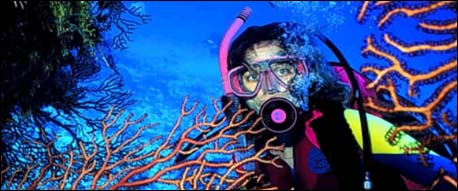
Whole
Sales
SPONSORED
LINKS
Scuba
Scuba stands for self-contained underwater breathing apparatus. Scuba divers carry a tank of air that allows them to breathe while deep underwater.

Technique Diving or Tek Diving
There are
mainly three type of tek diving. Nitrox diving,
Rebreather diving and Ice diving. It is important
to have undergone some training before taking
these type of dives.
Nitrox
diving
The nitrox used by a diver is in fact air where
the oxygen has been enriched 30 to 50%. This is
done to counteract the toxic effects of nitrogen
which can arise at depths of 30 metres. The
mixture used doesn't let you dive much deeper than
this as its effects will not be felt after a
certain depth. On the other hand you will be able
to dive for a lot longer than from a surface
dive.
Rebreather
diving
Rebreather uses a nitrox mix and one of its
advantages is rebreather does not emit bubbles the
way open-circuit scuba does, divers are quieter
and can interact more freely with marine life.
The technology used in this device, recycle the
air exhaled by the diver, thus increasing the air
supply underwater. The air supply of such units
lasts from about 45 minutes to 2 hours. Exhaled
air passes through a regeneration chamber; carbon
dioxide is removed; the air is then combined with
oxygen and air from the cylinder; and then it is
rebreathed.
Ice
diving
For ice diving one will need specialised technical
equipment. It's necessary to wear a dry suit as
the waters temperature averages around the 0°
mark. Using a recovery cord is vital, if you want
to find your way back to the surface that is! Ice
dives aren't something you do off the cuff;
preparation and organisation are vital. Some clubs
in France and abroad can offer these types of
dives.
VIEW SCUBA GUIDE

|